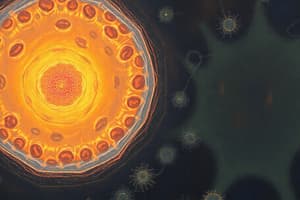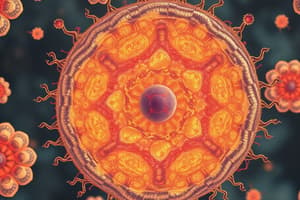Podcast
Questions and Answers
What is the primary composition of the plasma membrane?
What is the primary composition of the plasma membrane?
- Protein layer
- Phospholipid bilayer (correct)
- Cholesterol layer
- Phospholipid monolayer
Which of the following is NOT a characteristic of prokaryotic cells?
Which of the following is NOT a characteristic of prokaryotic cells?
- Have membrane-bound organelles (correct)
- Contain ribosomes
- Contain DNA in a nucleoid region
- Lack a true nucleus
Which organelle is responsible for energy processing in cells?
Which organelle is responsible for energy processing in cells?
- Golgi apparatus
- Mitochondria (correct)
- Ribosomes
- Nucleus
What is the function of a capsule in prokaryotic cells?
What is the function of a capsule in prokaryotic cells?
Which structure is found only in plant cells and not in animal cells?
Which structure is found only in plant cells and not in animal cells?
What role do lysosomes play in eukaryotic cells?
What role do lysosomes play in eukaryotic cells?
What is the primary purpose of the cytoskeleton in a eukaryotic cell?
What is the primary purpose of the cytoskeleton in a eukaryotic cell?
Which component is involved in the manufacture, distribution, and breakdown of molecules in eukaryotic cells?
Which component is involved in the manufacture, distribution, and breakdown of molecules in eukaryotic cells?
What role does the nucleus play in a cell?
What role does the nucleus play in a cell?
What distinguishes free ribosomes from bound ribosomes?
What distinguishes free ribosomes from bound ribosomes?
Which structure is part of the endomembrane system?
Which structure is part of the endomembrane system?
What is the primary function of vesicles within the endomembrane system?
What is the primary function of vesicles within the endomembrane system?
What differentiates rough endoplasmic reticulum (ER) from smooth ER?
What differentiates rough endoplasmic reticulum (ER) from smooth ER?
Which of the following correctly describes the function of the Smooth Endoplasmic Reticulum?
Which of the following correctly describes the function of the Smooth Endoplasmic Reticulum?
What is the primary role of the Rough Endoplasmic Reticulum?
What is the primary role of the Rough Endoplasmic Reticulum?
What occurs to polypeptides once they are synthesized and reach the Rough ER?
What occurs to polypeptides once they are synthesized and reach the Rough ER?
What is the function of the Golgi apparatus in the cell?
What is the function of the Golgi apparatus in the cell?
How does the Golgi apparatus process proteins from the Rough ER?
How does the Golgi apparatus process proteins from the Rough ER?
What is the 'maturation model' in relation to the Golgi apparatus?
What is the 'maturation model' in relation to the Golgi apparatus?
What does the Golgi apparatus do at its shipping side?
What does the Golgi apparatus do at its shipping side?
Which part of the Golgi apparatus is responsible for receiving transport vesicles from the ER?
Which part of the Golgi apparatus is responsible for receiving transport vesicles from the ER?
What is the primary function of mitochondria in cells?
What is the primary function of mitochondria in cells?
What structure within the mitochondria increases the surface area for ATP production?
What structure within the mitochondria increases the surface area for ATP production?
Which of the following components is found in the mitochondrial matrix?
Which of the following components is found in the mitochondrial matrix?
How many membranes enclose the mitochondria?
How many membranes enclose the mitochondria?
What is produced as a result of cellular respiration in mitochondria?
What is produced as a result of cellular respiration in mitochondria?
What is the primary function of cilia?
What is the primary function of cilia?
How do flagella differ from cilia?
How do flagella differ from cilia?
What type of junction forms impermeable seals between neighboring cells?
What type of junction forms impermeable seals between neighboring cells?
What role do integrins play in animal cells?
What role do integrins play in animal cells?
What best describes primary ciliary dyskinesia (PCD)?
What best describes primary ciliary dyskinesia (PCD)?
What is the primary function of chloroplasts in cells?
What is the primary function of chloroplasts in cells?
Which statement is true regarding mitochondria?
Which statement is true regarding mitochondria?
What is the primary role of microfilaments in cells?
What is the primary role of microfilaments in cells?
Which type of protein fiber is known for being strong and composed of fibrous proteins?
Which type of protein fiber is known for being strong and composed of fibrous proteins?
What is a key component of the stroma in chloroplasts?
What is a key component of the stroma in chloroplasts?
How do microtubules contribute to cell division?
How do microtubules contribute to cell division?
Which structure is responsible for contraction in muscle cells?
Which structure is responsible for contraction in muscle cells?
What role do centrioles play during cell division?
What role do centrioles play during cell division?
Flashcards are hidden until you start studying
Study Notes
Plasma Membrane
- The plasma membrane is a flexible boundary between the cell and its surroundings.
- It is composed of a phospholipid bilayer with hydrophilic heads facing outwards and hydrophobic tails inwards.
Prokaryotic Cells
- Simpler than eukaryotic cells, including bacteria and archaea.
- Contain chromosomes carrying genes of DNA, cytoplasm, and a nucleoid containing coiled DNA.
- Have a cell wall for protection, a capsule for movement, and flagella for propulsion.
Eukaryotic Cells
- More complex than prokaryotic cells, with a nucleus and organelles.
- Consist of functional groups:
- Nucleus and ribosomes for genetic control.
- Organelles for molecule manufacture, distribution, and breakdown.
- Mitochondria and chloroplasts for energy processing.
- Cytoskeleton, plasma membrane, and cell wall for structural support, movement, and communication.
- Engage in cellular metabolism and have fluid-filled spaces.
- Lysosomes and centrioles are found only in animal cells, while plant cells have thick cell walls, plasmodesmata, chloroplasts, and vacuoles.
The Nucleus and Ribosomes
- The nucleus is the command center containing DNA and directs protein synthesis.
- Ribosomes assemble proteins based on the mRNA sequence synthesized in the nucleus.
- Free ribosomes are located in the cytoplasm and synthesize proteins that function within the cytoplasm.
- Bound ribosomes are attached to the endoplasmic reticulum and synthesize proteins for secretion or membrane insertion.
The Endomembrane System
- A network of membranes in eukaryotic cells involved in protein synthesis, transport, and modification.
- Contains vesicles, small membrane-bound sacs, for transferring materials between membranes.
- Components include:
- Nuclear envelope
- Endoplasmic reticulum (ER):
- Smooth ER
- Rough ER
- Golgi apparatus
- Lysosomes
- Vacuoles
- Plasma membrane
Endoplasmic Reticulum and Golgi Apparatus
- The endoplasmic reticulum is a biosynthetic factory.
- Smooth ER: lacks attached ribosomes and synthesizes lipids, phospholipids, steroids, breaks down certain drugs and alcohol, and stores calcium ions.
- Rough ER: has attached ribosomes and synthesizes membranes and proteins for membrane formation.
- Secretary Protein Processing involves folding and glycosylation of polypeptides in the rough ER, followed by transport in vesicles to the Golgi apparatus for final modifications.
- The Golgi apparatus packages, sorts, and ships cell products. It is a stack of flattened sacs with a number of sacs reflecting the cell's protein production activity.
- The Golgi apparatus receives transport vesicles from the ER, modifies products as they pass through, and ships them in vesicles to the plasma membrane or other organelles through maturation.
Mitochondria
- Energy-converting organelles, harvesting chemical energy from food.
- Have two membranes: an outer and inner membrane, creating two compartments: intermembrane space and mitochondrial matrix.
- The mitochondrial matrix contains mitochondrial DNA, ribosomes, and enzymes for cellular respiration.
- Cristae, folded inner membranes, increase surface area for ATP production.
- Mitochondria carry out cellular respiration, converting food to ATP, the main energy source for cells.
Chloroplasts
- Convert light energy into chemical energy more efficiently than any human creature.
- Contain many interconnected organelles with internal membranes playing a critical role.
- The stroma forms an outer framework comprised of membranes and vesicles, housing enzymes for chemical reactions.
- Granum consists of layers for maximizing light capture and energy conversion.
Cytoskeleton and Cell Surfaces
- The cytoskeleton is a network of protein fibers in the cytoplasm, providing structural support and cell mobility.
- It interacts with other materials and consists of three main fibers:
- Microfilaments: support cell shape and cause muscle contraction.
- Intermediate Filaments: reinforce cells and connective tissues.
- Microtubules: guide organelles during cell division and form spindles.
Cell Structures and Junctions
- Cilia and flagella are microtubule-based structures for cell movement.
- Cilia are short and numerous, propelling protists.
- Flagella are longer and fewer in number.
- Both are covered by a plasma membrane extension and anchored by a basal body.
- Sperm motility is influenced by the arrangement and density of components within the sperm.
- PCD (primary ciliary dyskinesia) is a rare disease involving misdirected cilia.
Components of Animal Cells
- The extracellular matrix (ECM) connects and regulates animal cells.
- It is a matrix of proteins holding cells together.
- Integrins span the membrane and interact with the ECM and cytoskeleton, transmitting signals between cells and the ECM.
Cell Junctions in Animal Tissues
- There are three main types of cell junctions:
- Tight Junctions: tightly bind neighboring cells, preventing fluid leakage.
- Anchoring Junctions: connect cells together, forming strong sheets resistant to mechanical stress.
- Gap Junctions: form channels between cells, allowing communication and small molecule passage.
Studying That Suits You
Use AI to generate personalized quizzes and flashcards to suit your learning preferences.




